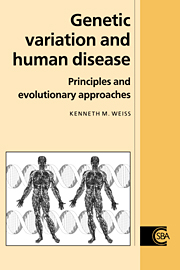Book contents
- Frontmatter
- Contents
- Frontispiece
- Preface: what is this book all about?
- Notational conventions used in this book
- List of abbreviations
- Part I Genes and their expression
- Part II Introduction to genetic epidemiology: inference from observational data
- Part III Evolution: the time dimension in populations
- Part IV Modification of the inherited genotype: the time dimension in individuals
- 12 Phenotype amplification by the environment
- 13 Infectious disease: the response to biological challenge
- 14 Variation within the inherited genotype
- 15 Cancer and aging: a microcosm of evolution during life
- Afterwords: towards a unified general model
- References
- Index
13 - Infectious disease: the response to biological challenge
from Part IV - Modification of the inherited genotype: the time dimension in individuals
Published online by Cambridge University Press: 05 June 2012
- Frontmatter
- Contents
- Frontispiece
- Preface: what is this book all about?
- Notational conventions used in this book
- List of abbreviations
- Part I Genes and their expression
- Part II Introduction to genetic epidemiology: inference from observational data
- Part III Evolution: the time dimension in populations
- Part IV Modification of the inherited genotype: the time dimension in individuals
- 12 Phenotype amplification by the environment
- 13 Infectious disease: the response to biological challenge
- 14 Variation within the inherited genotype
- 15 Cancer and aging: a microcosm of evolution during life
- Afterwords: towards a unified general model
- References
- Index
Summary
Which also we prove by the suddain jumps which the Plague hath made … which Effects must surely be rather attributed to change of the Air, than of the Constitution of Mens Bodies.
J. Graunt, Bills of Mortality (1662)Offensive and defensive strategies against evolving threats
Infectious and parasitic diseases have been paramount among the threats to human health and survival for most of our (and our mammalian ancestors') evolutionary history. These diseases present three particular evolutionary problems. First is the essentially open-ended variety of pathogens to which we might be exposed. Secondly, while being able to attack nearly any kind of microorganism, we must be inhibited from attacking our own, very diverse, cells. Thirdly, we reproduce and can evolve genetic adaptations only slowly, but the pathogens that infect us typically reproduce in the millions, in days or even hours. These seem like evolutionary battles we could hardly win.
One way the immune system recognizes foreign pathogens is by their molecular structure; but in contrast to molecular recognition systems such as those between hormones and their receptors, which can be specifically programmed, the immune system has evolved to use a mechanism that can recognize an unlimited diversity of molecules {Roitt et al., 1989}. That mechanism forces us to revise the standard assumption that the inherited genome is constant during the life of an individual.
- Type
- Chapter
- Information
- Genetic Variation and Human DiseasePrinciples and Evolutionary Approaches, pp. 253 - 272Publisher: Cambridge University PressPrint publication year: 1993



